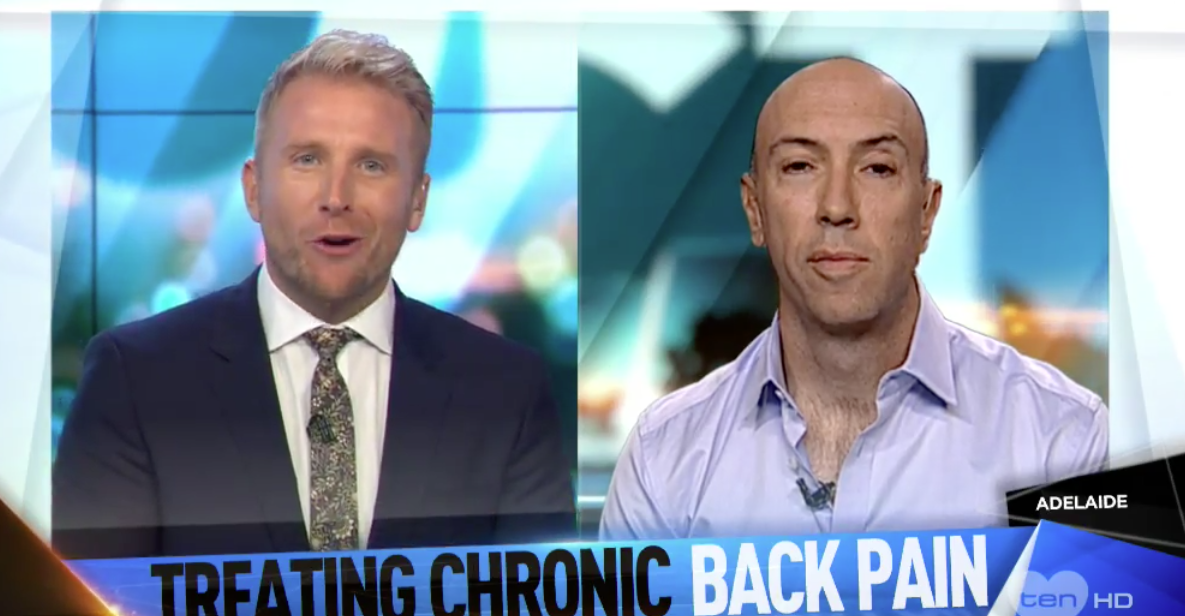
Back pain is in the news again, but perhaps this time for the right reason. The Lancet has just published a special series of three papers from a group of researchers from around the globe. Chaired by Professor Rachelle Buchbinder of Monash University, the papers focus on fundamentally changing how we think about back pain. The call to action is to move away from low value, ineffective passive approaches, including unnecessary scans, drugs, injections and surgery. Rather, and we reckon we’re preaching to the choir here, the focus should be on reconceptualising pain and encouraging people to remain active.
Back pain on prime time

The Lancet papers have been picked up by media across the globe – Professor Lorimer Moseley was on prime time television last night across Australia, and multiple outlets are reporting on the ineffectiveness, even harmfulness, of some current approaches to back pain.
Being at the coal face, you might want to get ready for the inevitable mixed reaction to this information being pushed out into the public domain. Some people experiencing back pain may feel their pain is being invalidated, others will be sick of being told, again, that ‘exercise is the cure’ (this is not the message of course, but not all media coverage has got it quite right).
Your Explain Pain game will need to be at its best, ready to answer questions such as But it really hurts, why should I exercise? They’re talking about ‘psychological approaches’ but it’s not in my $%^#ing head, is it!? If surgery and injections can’t fix it, then there’s really nothing I can do for it is there? Have you seen my scans – my discs have bulged and there are spurs – you really want me to move with a back like that?
A stable platform
Here’s a little something that might be appropriate, another nugget from Explain Pain Supercharged to add to your collection:
71. Stable Platform
So you say you’ve got a worn out back and the scans show degeneration. Well, I’ve had a really good look at your back movements and your scans and I think that the findings are more related to normal age changes and life events. Even though there is some loss of disc space and bony changes and your back’s a bit stiff, it’s actually quite a stable platform. I think you’ll be able to do most of the things that you want to do on this platform, such as play sports, walk the dog, go to work and so on. You should not be worried about damaging anything, in fact activity will lessen the chance of any damage happening.
If you’ve been banging on about this stuff like us…
For those of you, that like us, have been banging on for years about this stuff – reassuring people that their backs are healthy, strong and robust, that pain is of course real, but not an accurate indicator of the state of the tissues, and that healthy movement, good sleep, and understanding the problem is the best way to get back into life – The Lancet low back pain papers won’t bring anything particularly new, but they should encourage you to keep fighting the good fight and provide some extra evidence to keep in your back pocket if you come across resistance.
As always, thoughts, comments, discussion or questions welcome below.
-Noigroup
Knowledge Driving Health
Find an Explain Pain course
Related ‘jams
Education can change the world, but can it change back pain?

Reconceptualising pain does seem to quite be a “tall order”. However, by coincidence, our paper, which has just been published as Open Access in PAIN Reports, is an attempt to address this issue. Let the conversation now begin! https://journals.lww.com/painrpts/Abstract/latest/Reconsidering_the_International_Association_for.99934.aspx
Hi, it’s seeming to me that the vanguard besides your work, lies with the Sarno-derived work of Howard Schubiner MD & Allan Abbass MD (their brand new book is “Hidden from View”), the related work of Alan Gordon LCSW (http://www.tmswiki.org), and Michael Moskowitz MD (neuroplastix.com). What do you NOI folks think of those approaches? If good, any chance of collaboration? Thanks
Charles, although I have not read their book, the work of the late Dr John Sarno, and those who have carried it on, is likely to lead us down a “blind alley”. Here is my supporting evidence: http://www.fmperplex.com/2016/06/14/fibromyalgia-and-the-sarno-connection/